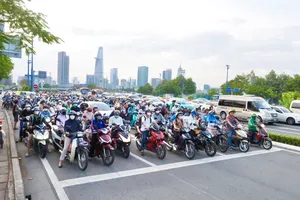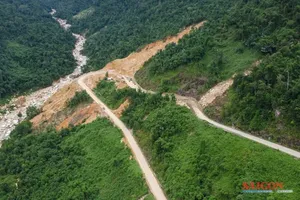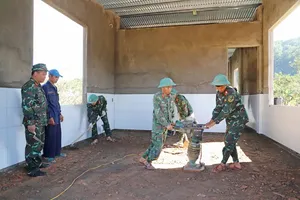
According to the National Center for Hydrometeorological Forecasting, typhoon Kalmaegi is expected to move into the East Sea, becoming the country’s 13th storm in 2025.
Once it enters the East Sea, the storm is forecast to intensify to levels 13–14 (134–166 km/h), with gusts reaching levels 16–17 (184–202 km/h or higher), moving toward the sea and coastal areas of the Central and South-Central regions.
It could reach levels 13–14 (134–166 km/h) with gusts reaching 184–202 km/h around the Truong Sa Archipelago in Khanh Hoa Province and offshore areas from Da Nang to Khanh Hoa, and levels 12–13 (118–149 km/h) with gusts above 167 km/h near coastal areas and Ly Son Island.
Heavy rainfall and downpours are expected from Ha Tinh to Khanh Hoa provinces.
This typhoon is classified as extremely powerful and is projected to strengthen significantly as it moves into the East Sea. Meteorological forecasts indicate that it will bring an expansive swath of intense winds.
Following the recent period of prolonged and devastating flooding in the Central region, the Prime Minister has urged immediate and resolute action to prepare for the approaching typhoon Kalmaegi and potential subsequent flood events. Provincial authorities from Da Nang to Khanh Hoa have been instructed to reassess their disaster response strategies and ensure that emergency protocols can be activated without delay.
The Prime Minister underscored the critical importance of maintaining maximum vigilance, comprehensive preparedness, and swift, coordinated response efforts. Authorities are urged to proactively plan for the most severe scenarios to guarantee the utmost protection of human life, reduce potential losses to property, and eliminate any risk of delayed or reactive decision-making in the face of natural disasters.
Local authorities from Da Nang to Khanh Hoa must mobilize the machinery of local government, focusing on leadership, coordination, and supervision of storm preparedness and flood response efforts.
Based on updated forecasts and local conditions, authorities in above-mentioned localities are instructed to restrict or ban fishing vessels and other marine activities when necessary with notice of thunderstorms and lightning risks even before the storm’s direct impact. They should also consider limiting land transportation during periods of strong winds and heavy rain to prevent accidents and ensure public safety.
The Minister of National Defense is assigned to ensure the safety of military personnel, equipment, and assets; direct military regions and units in storm-prone areas to review contingency plans; and prepare forces and means to assist localities in disaster prevention, response, and rescue operations as needed. Additional support forces and resources must be ready for deployment upon local request.
The Minister of Public Security is tasked with preparing police forces and equipment to maintain public order, assist in evacuation and rescue efforts, and respond to potential disasters such as floods, landslides, flash floods, and storm surges.
Meanwhile, the Chief of the Office of the National Civil Defense Steering Committee, in coordination with the Ministry of Agriculture and Environment and relevant agencies, is directed to closely monitor developments, review response scenarios, and proactively coordinate and mobilize resources to support localities in storm and flood response according to assigned functions and responsibilities.
























